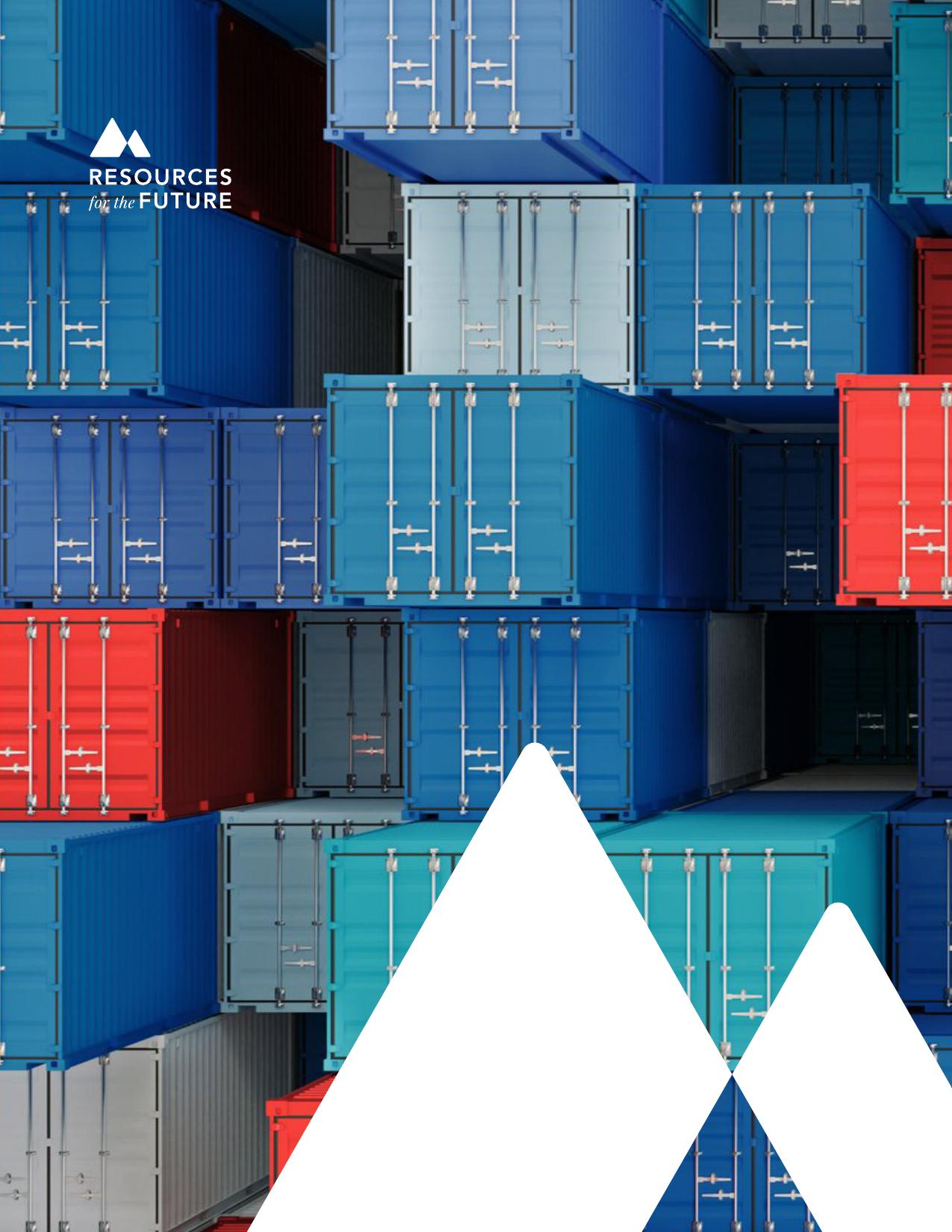ComparingtheEuropeanUnionCarbonBorderAdjustmentMechanism,theCleanCompetitionAct,andtheForeignPollutionFeeActMilanElkerbout,RayKopp,andKevinRennertReport23-18December2023ComparingtheEuropeanUnionCarbonBorderAdjustmentMechanism,theCleanCompetitionAct,andtheForeignPollutionFeeActAAbouttheAuthorsMilanElkerboutisafellowatRFFworkingoninternationalclimatepolicyandonEuropeanclimatepoliciestodecarbonizeenergy-intensiveindustriesinparticular.HehasworkedextensivelyontheEuropeanUnion’semissionstradingsystem(EUETS),itsvariousreforms,anditsroleindecarbonizingindustry.Elkerbouthasledpolicyresearchongreensteel,carboncaptureandcarbonremovals,carbonleakage,climateclubs,aswellastheEU’sresponsetotheCOVID-19pandemic,energycrisis,andUSInflationReductionAct.Hehasalsowrittenonindustrialandinnovationpolicy,thetrade-climatepolicynexus,andsupranationalgovernance,andhasworkedwithpolicymakers,industry,civilsociety,andacademia.ElkerbouthasabackgroundinEuropeanpoliticaleconomy.Between2014and2023,hewasworkingforCEPS,apolicythinktankinBrussels,asaresearchfellowandheadofitsclimateprogram.Fromspring2019,hespentayearasavisitingfellowatIVLStockholmaspartoftheMistraCarbonExitresearchprogram.RaymondKoppisaseniorfellowatResourcesfortheFuture(RFF).HeholdsPhDandMAdegreesineconomicsandanundergraduatedegreeinfinance.HehasbeenamemberoftheRFFresearchstaffsince1977andhasheldavarietyofmanagementpositionswithintheinstitution.Kopp’sinterestinenvironmentalpolicybeganinthelate1970s,whenhedevelopedtechniquestomeasuretheeffectofpollutioncontrolregulationsontheeconomicefficiencyofsteamelectricpowergeneration.HethenledthefirstexaminationofthecostofmajorU.S.environmentalregulationsinafull,generalequilibrium,dynamiccontextbyusinganapproachthatisnowwidelyacceptedasstate-of-the-artincost-benefitanalysis.DuringhiscareerKopphasspecializedintheanalysisofenvironmentalandnaturalresourceissueswithafocusonfederalregulatoryactivity.Heisanexpertintechniquesofassigningvaluetoenvironmentalandnaturalresourcesthatdonothavemarketprices,whichisfundamentaltocost-benefitanalysisandtheassessmentofdamagestonaturalresources.Kopp’scurrentresearchinterestsfocusonthedesignofdomesticandinternationalpolicestocombatclimatechange.KevinRennertisafellowatRFF,wherehefirstjoinedasavisitingfellowin2017.PriortohisarrivalatRFF,RennertservedasdeputyassociateadministratorfortheOfficeofPolicyattheUSEnvironmentalProtectionAgency.LeadinguptohisappointmentintheOfficeofPolicy,heworkedassenioradvisoronEnergyfortheSenateFinanceCommittee.Inthatrole,Rennertadvisedthecommittee’sChairman,SenatorRonWyden(D-OR),onawiderangeoftopicsrelatedtocleanenergy,efficiency,andpoliciestoreducegreenhousegasemissions.From2008to2014,heworkedonenergyandclimatelegislationasseniorprofessionalstafffortheSenateEnergyCommittee.Inthatcapacity,RennertledthedevelopmentoftheCleanEnergyStandardActof2012(S.2146),apresidentialprioritythatwouldusemarketmechanismstodoubletheamountofelectricitygeneratedintheUSfromloworzerocarbonsourcesby2035.In2010and2011,RennertalsotaughtgraduatecoursesinenergypolicyasadjunctfacultyintheDepartmentofStrategicManagementandPublicPolicyatGeorgeWashingtonUniversity.ResourcesfortheFutureiAboutRFFResourcesfortheFuture(RFF)isanindependent,nonprofitresearchinstitutioninWashington,DC.Itsmissionistoimproveenvironmental,energy,andnaturalresourcedecisionsthroughimpartialeconomicresearchandpolicyengagement.RFFiscommittedtobeingthemostwidelytrustedsourceofresearchinsightsandpolicysolutionsleadingtoahealthyenvironmentandathrivingeconomy.TheviewsexpressedherearethoseoftheindividualauthorsandmaydifferfromthoseofotherRFFexperts,itsofficers,oritsdirectors.SharingOurWorkOurworkisavailableforsharingandadaptationunderanAttribution-NonCommercial-NoDerivatives4.0International(CCBY-NC-ND4.0)license.Youcancopyandredistributeourmaterialinanymediumorformat;youmustgiveappropriatecredit,providealinktothelicense,andindicateifchangesweremade,andyoumaynotapplyadditionalrestrictions.Youmaydosoinanyreasonablemanner,butnotinanywaythatsuggeststhelicensorendorsesyouoryouruse.Youmaynotusethematerialforcommercialpurposes.Ifyouremix,transform,orbuilduponthematerial,youmaynotdistributethemodifiedmaterial.Formoreinformation,visithttps://creativecommons.org/licenses/by-nc-nd/4.0/.ComparingtheEuropeanUnionCarbonBorderAdjustmentMechanism,theCleanCompetitionAct,andtheForeignPollutionFeeActiiAbstractInatworecentpublications,CarbonBorderAdjustments:DesignElements,Options,andPolicyDecisionsandForeignPollutionFeeAct:DesignElements,Options,andPolicyDecisions,weprovidedanoverviewandcomparisonofcurrentborderadjustmentmechanisms(BAMs).InthefirstpublicationwefocusedontheEuropeanUnion’sCarbonBorderAdjustmentMechanism(EUCBAM);theFair,Affordable,Innovative,andResilientTransitionandCompetitionAct(FAIRAct),sponsoredbySenatorChrisCoons(D-DE);andtheCleanCompetitionAct(CCA),bySenatorSheldonWhitehouse(D-RI).InthesecondpublicationwereviewedanewpieceofproposedUSSenatelegislation,theForeignPollutionFeeAct(FPFA),introducedbySenatorBillCassidy(R-LA),SenatorLindseyGraham(R-SC),andSenatorRogerWicker(R-MS).InthisreportweprovidemoredetailontheEUCBAMandcompareittotheFPFAandtheCCA,whichwasreintroducedonDecember6,2023.1ThisreportusesthedesignelementsintroducedinthepreviouspublicationstodescribethepoliciesreflectedineachBAM.21AgreatdealoftheFPFAdescriptionusedinthisreportisreproducedfromourpublicationForeignPollutionFeeAct:DesignElements,Options,andPolicyDecisions.2Wehavemadeeveryefforttobeconcisewithrespecttoourdescriptionsofthedesignelements,butthathasrequiredustoabstractfromagreatdealofdetailineachBAM.Wehopethisreportwillprovidearoadmapthatinformsunderstandingofthesemechanisms,butitshouldnotbeinterpretedasacompleteandcomprehensivedescriptionandreview.ResourcesfortheFutureiiiContents1.Goals�11.1.EUCBAM�11.2.CCA�11.3.FPFA�22.CoveredProducts�22.1.EUCBAM�22.2.CCA�22.3.FPFA�33.Fees�33.1.EUCBAM�33.2.CCA�43.3.FPFA�54.DefinitionofGHGIntensity�74.1.EUCBAM�74.2.CCA�84.3.FPFA�85.Baselines�95.1.EUCBAM�95.2.CCA�105.3.FPFA�106.InformationResourcesandMethods�116.1.EUCBAM�116.2.CCA�116.3.FPFA�127.Clubs,Alliances,andExemptions�127.1.EUCBAM�127.2.CCA�137.3.FPFA�138.Takeaways�14ComparingtheEuropeanUnionCarbonBorderAdjustmentMechanism,theCleanCompetitionAct,andtheForeignPollutionFeeActiv1.GoalsEachofthethreeBAMsdiscussedinthisreportsharetwocommongoals.Thefirstgoalistoprotectthecompetitivenessofdomesticindustriesengagedininternationaltradewhiletheytakeactionstoreducetheiremissions.Theenvironmentaljustificationforprotectingdomesticcompetitivenessistheriskofcarbonleakage,wheredomesticclimatepoliciesmightinduceashiftinemissionstootherregions,thusundercuttingtheeffectivenessofthepolicy.Whileactionstomitigatetheriskofcarbonleakagecanalsosupportcompetitiveness,andviceversa,theydonotnecessarilydosoequallyinallcases.Thesecondgoalistoincentivizetradingpartnerswithlessambitiousclimategoalstoincreasetheirambitionandtherebyretainaccesstothemarketsofhigh-ambitioncountries.EachBAMhasoneormoreadditionalcomplementarygoals.Forexample,acomplementarygoalcanbepairingaBAMwithanewdecarbonizationregulatoryprogram.1.1.EUCBAMTheEUCBAMisdesignedtoworkhandinglovewiththeEUEmissionsTradingSystem(ETS),acarbonpricingworkhorsepolicyforthedecarbonizationofEUindustryandoftheEuropeanUnioningeneral.Inaddition,theEUCBAMincentivizesothertradingnationstoadoptcarbonpricingasafoundationaldecarbonizationpolicytool.1.2.CCATheCCAisalsoaBAMdesignedtoworkseamlesslywithadomesticregulatoryprogramintendedtoreducegreenhousegas(GHG)emissionsfromtheindustrialsector.TheCCAintroducesaperformancestandardtoachievethereductionsdesiredwithintheindustrialsector.1TheperformancestandardwithintheCAAisdefinedastonsofGHGspertonofproduct.ProducerswithaGHGintensityabovethebenchmarkpayafeewhileproducersbelowthebenchmarkpaynofee.ToensurearapiddeclineinGHGintensityovertime,thebenchmarkdeclinesyearoveryearandthefeeincreasesyearoveryear.Revenuesfromfeesareusedtofurtherincentivizeinvestmentsinlow-carbontechnologiesandotheractivitiesdesignedtoreduceindustrialemissions.1Itcanbearguedthataperformancestandardispreferabletoacarbontaxinaninternationallycompetitiveindustrialsettingduetothefactthatitdoesnotcauseindustrialsectoroutputpricestoincreaseasmuchastheywouldunderacarbonpricethatachievesthesamelevelofemissionreduction.ComparingtheEuropeanUnionCarbonBorderAdjustmentMechanism,theCleanCompetitionAct,andtheForeignPollutionFeeAct11.3.FPFAAkeydistinctionoftheFPFAfromtheothertwoapproachesisthattheFPFAdoesnotincludearegulatoryprogramtoreduceindustrialemissions.ThisisinlinewiththeFPFA’sobjectivetoreducetheimportationofembodiedGHGswithinUStradeflowsratherthanfocusonfurtherreductionsinemissionsfromdomesticsources.2.CoveredProducts2.1.EUCBAMInthedesignofaBAM,oneexpectstoseethelistofcoveredproductsdominatedbyprimarycommoditieswithrelativelyhighGHGintensities(i.e.,tonsofembodiedGHGspertonofproduct).TheEUCBAMincludessixcategoriesofcoveredproductsincludingcement,electricity,fertilizers,ironandsteel,aluminum,hydrogen,andchemicals.Withineachcategory,exceptforelectricityandhydrogen,therearemultipleindividualproductssubjecttotheEUCBAM.Forexample,inthecaseofcement,thecoveredproductsincludeotherkaolinicclays,clinkers,whitePortlandcement,otherPortlandcement,aluminouscement,andotherhydrauliccements.Inthecaseoffertilizers,therearefiveindividualcoveredgoodsspecified;forironandsteeltherearefourteenandfourteenforaluminumaswell.ThelistofcoveredgoodsisbasedonCombinedNomenclature(CN)codes,whichistheEuropeanUnion’scustomsandtradestatisticsclassificationsystembasedontheglobalHarmonizedSystem(HS)nomenclature.CNcodescanrunuptoeightdigits,althoughsomeEUCBAMgoodscategoriesarebasedontwofour-digitcodes,withspecificexemptions.Inthecaseofironandsteel,forexample,thismeansthatthelistofcoveredgoodsattheeight-digitlevelrunsatover100goods.2.2.CCATheCCAleviesfeesoncoveredprimarygoodsandproductswellas“finishedgoods.”Coveredproductsaredefinedbyfirstdefiningacoverednationalindustrywithasix-digitNAICScode.Thereare20definednationalindustries.2LiketheEUCBAM,eachcoverednationalindustryproducesamultitudeofindividualproducts.TheCCA2TheCCAcoverednationalindustriesincludepetroleumextraction,naturalgasextraction,surfacecoalmining,undergroundcoalmining,pulpmills,papermills,paperboardmills,petroleumrefineries,asphaltpavingmixtureandblockmanufacturing,asphaltshingleandcoatingmaterialsmanufacturing,allotherpetroleumandcoalproductsmanufacturing,petrochemicalmanufacturing,industrialgasmanufacturing,ethylalcoholmanufacturing,otherbasicorganicchemicalmanufacturing,nitrogenousfertilizermanufacturing,glass,cement,limeandgypsumproductmanufacturing,ironandsteel,andaluminum.ResourcesfortheFuture2definesacoveredprimaryproductas“anygoodwhichisproducedaspartofatradeorbusinessoperatingwithinacoverednationalindustryandincludesanygoodclassifiableunderthesame6-digitsubheadingoftheHarmonizedTariffSchedule(HTS)oftheUnitedStates.”Thelistofcoveredprimaryproductsexceedsseveralhundred.Finishedgoodsareproductsthatincludemorethan500poundsofanycombinationofcoveredprimaryproductintheirmanufacture,“or[were]producedfrominputsofanycombinationofcoveredprimarygoods,thevalueofwhichcomprisemorethan90percentofthetotalvalueofthematerialinputsinvolvedintheproductionofsuchgood[s].”Astimepassestheweightandvaluetriggersdecrease.Finishedgoodsarechargedafeebasedonthequantityofcoveredprimaryproductscontainedwithinthefinishedgoodmeasuredbyweight.IncomparisontotheEUCBAM,theCCAincludesmanymorecoveredprimaryproducts.UnliketheEUCBAM,theCCAimposesfeesonfinishedgoodsinadditiontoprimaryproducts.Thelistofsuchfinishedgoodscanbeextraordinarilylarge.2.3.FPFATheFPFAleviesfeesoncoveredprimarygoodsandproductsaswellastwocategoriesof“finishedgoods”(manufacturedproducts).Thecategoriesofcoveredproductsarealuminum,biofuels,cement,crudeoil,glass,hydrogen,methanol,ammonia,ironandsteel,lithium-ionbatteries,severalclassesofcriticalminerals,naturalgas,petrochemicals,plastics,pulpandpaperproducts,refinedpetroleumproducts,solarcellsandpanels,andwindturbines.TheFPFAthendefinesthecoveredproductsthataresubjecttotheimposedfeeswithineachlargecategoryusingthesix-digitHTScode.Dependinguponthecategory,asubstantialnumberofproductswillbesubjecttofees.TheFPFAhasauniquefeatureamongthethreeBAMsthatallowsdomesticproducerstopetitiontheUSSecretaryofEnergytoaddtothelistofcoveredproductsaproductproducedbythatindustry.TheabilitytopetitiontheSecretarytoaddcoveredproductsextendstotradeorganizationsconsistingoftheproducersofsuchproducts,laborunionsassociatedwiththeproductionoftheproduct,aswellasindividualsemployedintheproductionofsuchproducts.3.Fees3.1.EUCBAMTheEuropeanUnionarguestheEUCBAMisanextensionoftheETS,underwhichindustrialfacilitiesoperatingwithintheEuropeanUnionmustsurrenderallowancesforeachtonofGHGsemittedfromtheirproductionfacilities.EUCBAMfeesresultfromtheobligationforimporters(termeddeclarants)ofcoveredproductstobuyandsurrender“CBAMcertificates”(virtualETSallowances)ontheETSmarketequaltotheGHGsembodiedinthecoveredproductstheywishtoimport.SinceETSallowancemarketpricesfluctuateinresponsetodemand,thereissomeuncertaintywithrespecttothepricedeclarantsmustpaytoimportcoveredproducts.ComparingtheEuropeanUnionCarbonBorderAdjustmentMechanism,theCleanCompetitionAct,andtheForeignPollutionFeeAct3IfthecountryoforiginofacoveredproducthasinplaceacarbonpricethatmustbepaidbytheproducerofthecoveredproductandthecarbonpriceisatleastequaltothepriceofanEUETSallowance,thepurchasepriceoftheETSallowanceswillberebatedinfulltotheimporter.Ifthecountry-of-origincarbonpriceisafractionoftheETSallowanceprice,thatfractionoftheallowancepurchasepricewillberebated.TheEUCBAMlargelyaimstoequalizetreatmentofdomesticproducersandimporters,buttherearetwopracticaldifferencesworthyofmention.DomesticproducersmustsurrenderallowancesequaltoGHGsemittedfromtheirfacilities,whiledeclarantsmustsurrenderallowancesequaltothegreenhousegasemissionsembodiedinindividualcoveredproducts—onefacility-basedandtheotherproduct-based.Second,EUindustrialsectorsreceivefreeallowancestocoveraportionoftheiremissions.But,totheextentthatEUproducersreceivefreeETSallowances,thenumberofEUCBAMcertificatestobesurrenderedwillbecommensuratelyreducedaswell.Beginningin2026,thesefreeallowanceswillbereducedoveraneight-yearperiod.Inaddition,attheendofeveryquarter,thedeclarantneedstoholdavolumeofEUCBAMcertificatesonitsaccount,equaltoatleast80percentoftheembeddedemissionsofthegoodsithasimportedsincethestartofthecalendaryear.TheeffectivecarbonpricepaidbyEUCBAMimporterscanthereforevarydependingonthetimingofthepurchases,muchlikedomesticEUproducersarealsofreetotimetheirallowancepurchases(butnotsurrendering)accordingtopreference.ThepriceofEUCBAMcertificatesislinkedtotheEUETSprice.Everycalendarweek,theEuropeanCommissioncalculatesandpublishestheaverageclosingpriceofEUETSallowancesfortheprecedingweek.TheEUCBAMfeewillthereforebroadlytracktheEUETSprice,withaminortimelag.Inprinciple,thefeeschargedforacquiringEUCBAMcertificateswillbeadjustedforanycarbonpricesalreadypaidinthecountrywherethegoodsoriginated.Inpractice,strictlyspeaking,theeffectivecarbonpricepaidwillleadtoareductioninthenumberofcertificatesthathavetobesurrendered,ratherthanalowerfeeperEUCBAMcertificate.3.2.CCATheCCAwouldestablishbothadomesticregulatoryprogramtoreducedomesticindustrialemissionsandabordermechanismthatwouldapplyfeestoimportedcoveredproductsbasedontheirembodiedGHGs.LiketheEUCBAM,theCCAworkstotreatimportersofcoveredproductsinthesamemannerthatittreatsdomesticproducersofthosesameproducts.TheheartoftheCCAisaperformancestandardbasedonabenchmarkspecifyingtonsofgreenhousegasesemittedpertonofproductproduced.TheCCAidentifiesabenchmarkforeachof20nationalindustries.ThebenchmarksareequaltothemeanGHGintensity(measuredastonsofGHGpertonofproduct)ofeachnationalindustry.Eachnationalindustryiscomposedofseveralcoveredentities(firmsproducingacoveredproduct)andeligiblefacilitiesownedbycoveredentities.ThebenchmarkistheResourcesfortheFuture4meanintensityoftheeligiblefacilitieswithinthenationalindustry.Eacheligiblefacilitymustcalculateitsfacility-levelGHGintensity.Ifthatintensityisbelowthebenchmark,theeligiblefacilitypaysnofees.However,ifthefacility-levelintensityisabovethebenchmark,itmustpayafeeoneverytonofGHGsemittedatthefacilityabovethebenchmark.Forexample,aneligiblefacilitywithaGHGintensityof4.0tonsofCO2epertonofproductproducing100,000tonsofproductfacinganationalindustrybenchmarkof2.0wouldpayafeeon200,000tonsofGHGs.TheCCAfee(termedacarbonprice)issetequalto$55pertonofGHGintheinitialyear.Eachfollowingyearthefeeisincreasedbytheconsumerpriceindexplusfivepercent.Thenationalindustrybenchmarksdeclineby2.5percenteachyearfrom2026–2029and5percenteachyearthereafteruntilitreacheszero.Eachimportedcoveredproductisassociatedwithanationalindustry.Intheinitialyear,importersof10,000tonsofacoveredproductwiththeGHGintensityof3.5associatedwiththeUSnationalindustrybenchmarkof0.5wouldpay$165,000infees((3.5-0.5)x10,000x$55).LiketheCBAM,domesticproducersarechargedfeesatthefacilitylevelwhileimportersarechargedfeesonindividualproducts.ThereisflexibilitywithintheCCAfordomesticproducerstopetitionfortheirGHGintensitiestobebasedonproductsratherthantheirfacilities.3.3.FPFATheprimegoaloftheFPFAistosignificantlyreduceGHGsembodiedinimportedproductsovera12-yearperiodandthentocontinuethereductionofimportedembodiedGHGsovertheyearstofollow.ThisgoalleadstheFPFAtohaveaverydifferentfeestructurethantheEUCBAMandtheCCA.Thefee,termedthe“variablecharge”inthelegislation,isanadvaloremfeespecifictoeachcoveredproductandtoeachtiertowhichacoveredproductisassigned.Thelegislationdefines3tiers,witheachtiercontainingmultiplesegments.Forexample,coveredproductswithaGHGintensitydifference(i.e.,thedifferencebetweentheGHGintensityofacoveredproductfromacountryoforiginrelativetotheaverageGHGintensitythesameproductproducedintheUS)greaterthan10percentbutnotgreaterthan50percentfallsintoTierA.WithinTierAaremultiplesegmentsestablishedatfivepercentagepointincrements(e.g.,10percent,15percent,20percent…).CoveredproductsfallingintoTierAarefurtherassignedtoaspecificsegment.TierBcontainscoveredproductswithaGHGintensitygreaterthan50percentbutnotgreaterthan200percentwhileTierCcontainscoveredproductswithaGHGintensitygreaterthan200percent.TiersBandCalsohavemultiplesegments.Theadvaloremfeesaredesignedtoachievespecificgoals.Inthefirstsixyearsafterenactment,coveredproductswithameanGHGintensitygreaterthan50percentofmeanUSproductionfaceanadvaloremfeesufficienttoensureimportsofthosecoveredproductsarealteredsuchthatthedifferenceinmeanGHGintensity(betweenComparingtheEuropeanUnionCarbonBorderAdjustmentMechanism,theCleanCompetitionAct,andtheForeignPollutionFeeAct5USproductsandimportedproducts)isnotgreaterthan50percent.CoveredproductswithameanGHGintensitygreaterthan25percentbutlessthan50percentofmeanUSproductionfaceanadvaloremfeesufficienttoensuretradeflowsofthatcommodityarealteredsuchthatthedifferenceinmeanGHGintensityisnotgreaterthan25percent.CoveredproductswithameanGHGintensitynotgreaterthan25percentofmeanUSproductionfaceanadvaloremfeesufficienttoensuretradeflowsofthatcommodityarealteredsuchthatthedifferenceinmeanGHGintensityisnotgreaterthan10percent.Inthesubsequentsix-yearperiod(Phases2and3)andbeyond,theadvaloremfeesareadjustedtocontinuethedeclineintheGHGintensityofcoveredimportedproductsinUStradeflows.Theprocessofsettingtheadvaloremfeecanbestdescribedasaseriesofsteps.•Step1calculatestheGHGintensityofeachimportedcoveredproductforeachofthecountriesoforiginandtheaverageGHGintensityofeachcoveredproductproducedintheUS.Informationfromthisstepallowseachcoveredproducttobeassignedtoatierandasegmentwithinatier.Itispossibleandperhapslikelythesamecoveredproductfromdifferentcountriesoforigincanbeassignedtodifferenttiersordifferentsegmentswithinatierduetosignificantdifferencesincountry-of-originGHGintensity.•Step2calculatestheaverageGHGintensityofindividualcoveredproductacrossallcountriesoforigin.InformationfromthisstepisusedtoalignthemagnitudeofthevariablechargewiththegoalsstatedabovepertainingtothereductionintheGHGintensityofimportedcoveredproducts.•Step3establishesthevariablechargetobeassignedtoaspecificcoveredproductresidinginaspecificsegmentofatier.Giventhelargenumberofcoveredproductsaswellasthenumberofsegmentswithineachofthethreetiers,theSecretaryofEnergywillbedevelopingalargenumberofvariablecharges.Giventhegoalsnotedabove,itseemsmostlikelytheSecretaryandtheBoardwillrelyonmodelingexercisesdesignedtoachievethestatedreductionsinGHGsembodiedincoveredproductstosetthemagnitudeofthevariablecharges.ResourcesfortheFuture64.DefinitionofGHGIntensityDefiningtheGHGintensityofacoveredproductisafoundationalelementofaBAM.WhiletherearemanyGHGaccountingprotocolsinexistence,GHGaccountinginthecontextofaBAMhasitsownrequirements.ItisimportanttorecognizethatBAMsareappliedtotradedproductsandnottofirmsorfacilities,andtheGHGaccountingmethodsmustalignwiththeHTSthatisthebasisforcustomstariffsworld-wide.WethinkofBAMGHGaccountingintermsoftheboundariesusedtodefinetherelevantemissionsofGHGs.3Therearethreebroadcategoriesofemissionsthatdefinetheboundaries:1)directemissionsfromtheproductionfacility,2)emissionsfromthegenerationofgridelectricitypurchasedbyproductionfacilities,aswellasfromheatconsumptioninproductionfacilities,and3)emissionsembodiedinintermediateproductspurchasedbyproductionfacilitiesforuseandthemanufacturerofcoveredproduct.TheseboundariesareoftentermedScope1(directemissions),Scope2(electricity-andheat-relatedemissions)andScope3(upstreamsupplychainemissions).Atthistime,weareunawareofanyBAMorproposedBAMthatexpandstheemissionsboundarytoincludedownstreamScope3emissions,beyondtheEUCBAM’s“precursors,”discussedfurtherbelow.4.1.EUCBAMTheboundaryconditionsfortheEUCBAMduringthetransitionalphasearequitestraightforwardandincludeScope1directmissionsandScope2emissionsfromgrid-providedelectricitygeneration.TherearenoupstreamsupplychainemissionsincludedinthecalculationofGHGintensity.TheEuropeanUnionplacestheburdenofcalculatingtheGHGintensityforimportedcoveredproductonthedeclarantbutprovidessomeguidancefordeclarantsinregulationsissuedMay10,2023.ForupstreamScope3emissions,theEuropeanUnionusestheconceptof“precursors.”PrecursorsarethegoodsthatareusedintheproductionprocessofthemaingoodcoveredbytheEUCBAM.Relevantprecursorsforwhichtheembeddedemissionsshouldbeaccountedfor,anddeclaredbyimporters,areexplicitlylistedinAnnexIIIoftheEUCBAMimplementingregulation.Thereasontoincludeprecursorsistoavoid“reshuffling”tradeinresponsetoEUCBAMobligations;theirinclusiondoesnotsignaladesirebytheEuropeanUniontobeginregulatingScope3emissions.FailuretoincludeprecursorswouldcreateanincentiveforproducerstosimplyshiftthetradetothepartofthesupplychainnotcoveredbytheEUCBAM.Crucially,theprecursorsundertheCBAMareregulatedfordomesticEUproducersastheScope1emissionsfromETSinstallations.3“Whatistheharmonizedsystem(HS)?”WorldCustomsOrganization,accessedDecember5,2023,https://www.wcoomd.org/en/topics/nomenclature/overview/what-is-the-harmonized-system.aspx.ComparingtheEuropeanUnionCarbonBorderAdjustmentMechanism,theCleanCompetitionAct,andtheForeignPollutionFeeAct74.2.CCATheCCAhasboundaryconditionsfordomesticproducersverysimilartotheEUCBAM—directemissionsandgrid-purchasedelectricityemissions.Inaddition,asnotedinthesectiononcoveredproducts,theCCAtrackstheemissionsofGHGsembodiedincoveredproductsthatareusedintheproductionoffinishedgoods.TheseupstreamsupplychainemissionsfallunderScope3andarenotincludedintheEUCBAM.TheCCAplacestheburdenofestablishingGHGintensitiesfordomesticandimportedcoveredproductsontheUSSecretaryoftheTreasury.Eligiblefacilityemissionscapturedandstoredinsecuregeologicalformationsmaybesubtractedfromtheemissionstotal.CoveredentitiesthatengageindirectaircaptureofGHGsmayapportionthosecapturedadmissionsamongtheireligiblefacilities.ThedefinitionandmeasurementoftheGHGintensityforimportedcoveredproductsisconsiderablydifferentthanitisfordomesticproducers.Asadefault,theGHGintensityofcoveredimportedproductsisdefinedbytheSecretaryasthecarbonintensityofthegeneraleconomyofthecountryoforigin.Ifitisbelievedthecountryoforigin’scoverednationalindustryhasagreenhousegasintensitylessthanthatofthegeneraleconomy,theSecretaryhastheoptionofestimatingtheintensityofthecoverednationalindustryandusingthatestimateasthebasisforthedeterminationoftheGHGintensityofthecoveredimportedproduct.ImportersofcoveredproductscanpetitiontheSecretarytousetheaverageGHGintensityofthecoveredentityinthecountryoforigin.4.3.FPFATheFPFAspecifiesthedeterminationoftheGHGintensityofthedomesticbenchmarkagainstwhichtheGHGintensityofimportedcoveredproductswillbecompared,aswellasthedeterminationoftheGHGintensityofimportedproducts.TheFPFA’smeasureofGHGintensityincludesScopes1,2,and3emissions.Scope1emissionsarereferredtointheFPFAaspointsourcepollution,meaningtheemissionofGHGsdirectlyfromafacilityproducingacoveredproduct.TheFPFAaddressesScope2electricityemissionsbydefiningaseparatecategoryofinputstermed“contributingparts.”Acontributingpartisaproductusedinthecreationofacoveredproduct—forexample,aproductusedtoprovideelectricitynecessarytooperatemachineryusedtocreatethecoveredproduct.TheFPFAreferencesupstreampollution—Scope3—asembodiedGHGsinanycoveredproductthatisusedasaninputinthemanufactureofanothercoveredproduct,aswellasanyfugitiveemissionsoccurringduringtheextraction,refining,andtransportoftheaboveintermediatecoveredproducts.Anexamplewouldbethefugitiveemissionsfromtheextraction,refining,andtransportofcrudeoilusedasaninputintheproductionofrefinedpetroleumproductsandpetrochemicals.Whilenotcalledassuch,theseScope3inputsareostensiblysimilartotheEUCBAM’sinclusionof“precursors”andarelikewisecoveredtopreventavoidanceor“reshuffling.”ResourcesfortheFuture8TheFPFAplacestheburdenofcalculatingthebaselinepollutionintensityandthepollutionintensityofimportedcoveredproductsontheSecretaryofEnergy.Thelegislationstates,ForthepurposesofcreatingaprocessforcalculatingthepollutionintensityofanycoveredproducttheSecretaryandtheBoardshallusethebestandmostgranulardataavailableintheUnitedStatestoestablishthebaselinepollutionintensitywithrespecttosuchproduct,andinthecaseofacoveredproductproducedoutsidetheUnitedStates,basethecalculationofthepollutionintensityofsuchproductontheprocessusedtoestablishthebaselinepollutionintensityforsuchproduct.4,5ThisexcerptinstructstheSecretaryofEnergytotreatthedeterminationofdomesticpollutionintensitiesandthoseofimportedgoodsinasimilarfashion.TheFPFAprovidestheSecretaryofEnergywithconsiderableflexibilityinthedeterminationofpollutionintensity,whichstandsincontrasttotheapproachoftheCCA,whichinsteadprovidesconsiderablespecificityinitsdirectiontotheSecretaryofTreasurywithrespecttothedeterminationofGHGintensity.5.BaselinesAbaselineisaproduct-levelGHGintensityagainstwhichtheGHGintensityofanimportedproductiscomparedforthepurposesofassessingborderfees.Whenused,baselinescandefineanexemptlevelofemissionsbeforeBAMchargesaccruetodefinecategoriesofGHGintensitiesforthepurposesofassigningBAMfees.5.1.EUCBAMTheEUCBAMdoesnotreferencesuchabaseline.Rather,forthepurposesofeffectivelyassigningborderfeestocoveredproductsorexemptingcoveredproductsfromborderfees,theEuropeanUnionreliesonthecomparisonofcarbonpricingpoliciesinthecountryoforiginwiththeEUETSallowanceprice.ThiscomparisonisdiscussedundertheFeessectionofthisreport.TheEuropeanUnion,however,isdevelopingfallbackapproachesincaseimportersfailtodeclareembeddedemissionsinlinewiththeEuropeanUnion’sspecifications.Inprinciple,theEuropeanUnionwantstoapplycountryaveragesforthevariousEUCBAMproducts.However,fornow,thereisnotsufficientdatatoestablishthese4TheBoardreferstotheNationalLaboratoryAdvisoryBoardonGlobalPollutionChallenges.TheBoardiscomposedofthedirectorsfromtheIdahoNationalLaboratory,theNationalRenewableEnergyLaboratory,thePacificNorthwestNationalLaboratory,andtheCouncilonEnvironmentalQuality.Inaddition,Boardmembersincluderepresentativesfromtheindustrialsectorsproducingcoveredproducts,aswellasrepresentativesfromrelevantfederalagencies.5ForeignPollutionFeeActof2023,S.3198,118thCong.(2023).ComparingtheEuropeanUnionCarbonBorderAdjustmentMechanism,theCleanCompetitionAct,andtheForeignPollutionFeeAct9countryaverages.ThisiswherethereportingduringtheEUCBAMtransitionalphaseuptotheendof2025comesin:bythentheEuropeanUnionhopestohavecollectedenoughdatatoestablishthesevalues.Failingatthat,theEuropeanUnionwouldmakeassumptionsabouttheembeddedcarboninimportedgoods.Itwoulddosobyassumingembeddedemissionsequaltothe”Xpercent”ofworst-performingEUfacilitiesinthesameproductgroup,withthevalueofXtobedeterminedbytheEuropeanCommissioninthefuture.ThelowerthisvaluethemoretheEuropeanUnionshieldsitsownproducers(butthelessitcanargueitisprimarilyconcernedwithavoidingleakage).5.2.CCATheCCAbaselineisthemeanfacility-level(eligiblefacility)GHGintensityforanationalindustry.Underavarietyofcircumstances,themeanintensitycanbecalculatedatamorerefinedleveltoreflectdifferencesintechnologiesusedinproductionandthecompositionproductsproducedwithinaneligiblefacility.Importantly,thebenchmarkwithintheCCAdeclinesovertimeincentivizingUSandforeignindustriestoinvestinlow-carbontechnologiesandundertakeotheractivitiestoreducetheirfacilityadmissions.AsnotedintheFeessectionofthisreport,bothdomesticfeesandimportfeesarereferencedtothebaseline.Coveredproducts,domesticorimported,withGHGintensitiesbelowthebenchmarkpaynofees.5.3.FPFATheFPFAspecifiesabenchmarkbasedonthefacility-levelpollutionintensityofdomesticproducersofaparticularcoveredproduct.Differencesbetweenthepollutionintensityofanimportedcoveredproductandthebaselineintensityareusedtoassigncoveredproductstodifferentcategories.ThesecategoriescarrywiththemdifferentadvaloremfeestobechargedtoimporterstoachievethegoalofreducingUSimportationofembodiedGHGs.UnliketheCCA,whichspecifiesascheduleusedtoreducethebenchmarkovertimetoachievedecarbonizationgoals,theFPFAbenchmarkchangesonlywhenperiodicallyrecomputedbytheSecretaryofEnergytoincorporateupdateddatareflectingthepollutionintensitiesofdomesticproducersatthattime.ResourcesfortheFuture106.InformationResourcesandMethods6.1.EUCBAMTheEuropeanUnionrequireselaboratemeasurement,reporting,andverificationoftheGHGemissionsofinstallationswithEUETScomplianceobligations.ThereportingisbasedonETS“activities,”whichhavetheirowntaxonomysetoutintheETSlegislation.ETSactivitycodesdonotmapto“products”or“goods”inthecontextoftrade,orindeedtotheeconomicclassificationsystemsusedintradeaccounting.WhileforthepurposesofsomeETSimplementationissuesrelatedtoallowanceallocation,GHGintensitiesarecalculatedbytheEuropeanCommissionasaregulator(basedoninstallationlevelreporting,combinedwithproductiondatainEurostat),EUproducersarenotobligedtodosothemselves.AnotherrelevantdistinctionfromEUCBAM“declarants,”isthatthesedeclarantsaretheimporters,whichinmanycasesmightbeadifferententityfromthemanufactureroftheproduct.6.2.CCATheCCAimposesGHGintensityreportingrequirementsondomesticmanufacturers.DomesticmanufacturersmustreporttotheSecretaryofTreasuryandtheAdministratoroftheUSEnvironmentalProtectionAgency(EPA)informationoneligiblefacilityemissionsandproductproductioninphysicaltermssuchthattheSecretarymaycalculatetheGHGintensityattheleveloftheeligiblefacility.Thiscalculationismadefortheaggregateofallproductsproducedataneligiblefacility.Thatis,theGHGemissionsspecifiedinthedefinitionofGHGintensity(theemissionsboundaryconditions)aredividedbythetonsofallproductsproducedataneligiblefacilityratherthanindividualproducts.Thelegislationdoesnotrequirethefacilityemissionstobeapportionedacrossallproductsproducedatthefacility.However,acoverednationalindustrymaypetitiontheSecretarytocalculateandprovideGHGintensitiesataproductlevel.OnecanexpectsuchpetitionsfromcoverednationalindustriesthatproduceavarietyofproductswithverydifferentindividualGHGintensities.Incasesofsuchpetitions,theSecretary,incoordinationwiththeAdministratormustdevelopamethodologyandassembledataforthecalculationofsuchintensitiesthatprovidesforinteroperabilitywithexistingfederalcarbonaccountingrulesandstandards.TheGHGintensitiesdevelopedbytheSecretaryandthechosenmethodologythenbecomepartofthepublicrecord.TheSecretaryisalsoresponsibleforthecalculationofGHGintensitiesforallcoveredprimarycommoditiesimportedintotheUnitedStates.TheSecretarymaybasethiscalculationontheGHGintensityofthegeneraleconomy(GHGintonsdividedbyGDP)ofthecountryoforigin,orifcredibleandverifiableinformationexists,maycalculatetheGHGintensityatthelevelofthecoverednationalindustry.Further,importersofacoveredproductmaypetitiontheSecretarytodeterminetheGHGintensityatthelevelofanindividualproductproducedbyanindividualmanufacturerwithinthecountryoforigin.ComparingtheEuropeanUnionCarbonBorderAdjustmentMechanism,theCleanCompetitionAct,andtheForeignPollutionFeeAct116.3.FPFATheFPFAassignstotheBoardtheresponsibilityofdevelopingestimatesofbaselinepollutionintensityofcoveredproductsandthepollutionintensityofcoveredproductsfromanycountryoforigin.TheBoardmaybaseestimatesofpollutionintensityoneconomic,statistical,orengineeringmodels;pollutiondatafromfacilitiesandawiderangeofmonitoringtools;voluntarilyreporteddata;informationontechnologyperformance;andinformationthatmaybespecifictoaparticularcoveredproduct.TheFPFAdirectstheBoardtoevaluatepollutionintensitiesforimportedcoveredproductsusingcalculationsbasedonthesameprocessusedtoestablishthepollutionintensityfordomesticproductionofthesamecoveredproduct(i.e.,thebaselinepollutionintensity).Ingeneral,thecalculationofpollutionintensitiesofimportedanddomesticcoveredproductsposesasignificanttechnicalchallengeintheimpositionofaBAM.TheFPFAputstheresponsibilityforcalculatingthesepollutionintensitiesupontheBoardanddirectsotherfederalagenciestosupplydatatosupportthecalculations.Incontrast,theCCAimposesGHGintensityreportingrequirementsondomesticmanufacturerstosupportitsassessmentofdomesticcarbonintensities.DomesticmanufacturersmustreportinformationtotheSecretaryofTreasuryandtheEPAAdministratoroneligiblefacilityemissions,productproduction,andotherrelevantinformationneededfortheSecretaryofEnergytocalculatetheGHGintensityattheleveloftheeligiblefacility.UndertheCCA,theSecretaryisalsoresponsibleforthecalculationofGHGintensitiesforallcoveredprimarycommoditiesimportedintotheUnitedStates.7.Clubs,Alliances,andExemptions7.1.EUCBAMInapreviousissuebrief,IndustrialDecarbonizationandCompetitiveness:BuildingaPerformanceAlliance,wedefinedthemostrudimentaryclubasacollectionofcountrieswheretransactionsandtradeinprimarycommoditiesisnotsubjecttoenvironmentallybasedfeesortariffsanddistinguishedbetweenapolicyclubandaperformanceclub.WesuggestedtheEUCBAMisarudimentarypolicyclub,meaningthatacountryavoidspayingfeesortariffsifthecountryhasaregulatoryemissionreductionpolicyequivalenttothatoftheEuropeanUnion.Thatis,itimposesacarbonpriceequaltoorgreaterthantheEUETSallowanceprice.ExemptionsarepoliticallydifficultinBAMs,asitcanbearguedtobediscriminatoryagainstthosenotexempted.Anobviousscenariowherecountriescouldbefullyexemptedisinthecaseoflinkedemissionstradingsystems.Insuchacase,thecarboncostsbetweenthedomesticandforeignproducerisbydefinitionequalandnoadjustmentisnecessary.TheEuropeanUnionhaslinkeditsETStotheSwissETS,leadingtoSwitzerlandbeingexemptedfromtheEUCBAM.However,ETSlinkagesarepoliticallyandtechnicallydifficult,andfewcountriesareunlikelytojoinSwitzerlandinthisexemption.ResourcesfortheFuture12DuringGermany’syearaspresidentoftheGroupofSeven(G7),afirst—verytentative—steptoaclimateclubwastaken.Climateclubsmeandifferentthingstodifferentcountriesandtherearenoreal-worldexamplesyet,althoughsomeannouncementsattheUnitedNations’28thConferenceofthePartiescanbeexpected.Ingeneral,aclimateclubwouldpursuealignmentbetweenclimatepolicies(andcarbonpricinginparticular)todifferentdegreesofharmonizationsothatfrictionisminimized,especiallywhenitcomestotrade.Clubsarebydefinitionexclusionary,leadingsomestakeholderstoprefertheconceptof“alliances”instead,signalingopennessforanyinterestedcountrytojoin(andalignwithcertainpolicypractices).TheUnitedStatesandtheEuropeanUnionareextensivelydiscussingtheGlobalArrangementonSteelandAluminum,seenbysomeasalimitedtransatlanticclimateclubduetoitsprovisionsonembeddedcarbonintheseenergy-intensivematerials.7.2.CCAWealsoarguedinIndustrialDecarbonizationandCompetitivenessthattheversionoftheCCAfirstintroducedinJune2022wasaperformanceclub.AperformanceclubdoesnotimposefeesortariffsonimportantcoveredproductsfromcountriesoforiginthathavethesameorbetterGHGintensitiesthanintheUnitedStates.ThiscontinuestobetrueforthenewversionoftheCCAintroducedinNovember2023.Inaddition,theCCAexemptsrelativelyleastdevelopednationsasdefinedinSection124ofthe1961ForeignAssistanceActfromcarbonfees.6NewinthereintroducedCCAisasectiontitled“CarbonClubs.”ThissectiongivestheSecretaryofTreasurytheauthoritytowaivefeesoncoveredproductsfromcountriesoforiginthatimposeexplicitcostsonGHGemissionssimilartothechargesthatwouldotherwisebeimposedbythelegislation.ItisreasonabletoassumecoveredproductsimportedfromtheEuropeanUnionwouldbeeligibleforwaivedfeesconsideringthecarbonpriceimposedbytheETS.7.3.FPFATheFPFAprovidesanextensivesectiononinternationalagreementsandpartnershipthatcanbecharacterizedasclubs.UndertheFPFA,theUSTradeRepresentativeisauthorizedtoengagewithcountriestoencouragetheestablishmentandexpansionofinternationalpartnerships.Suchpartnershipsmayincludeoneormorecoveredproducts,countries,orgroupsofcountries,suchastheOrganizationforEconomicCooperationandDevelopmentandtheG7.Partnershipswouldfacilitatethecreationofcompatiblemethodstopromotepollutionreductionthroughtrademechanismsbyfocusingonthepollutionintensitydifferencesbetweencountries(suggestingaperformanceclub).TheimpactofthispartnershipofferalsodependsontheprecisemandatefortheUSTradeRepresentative(ortheirinterpretationofthemandate):astrictinterpretationmightrequirealignmentwithUSpoliciesandregulationstosuchanextentthatitwillnotbefeasibleforeverycountrygiventhestructureoftheirdomesticpolicymix.6ForeignAssistanceActof1961,Pub.L.87–195,Section124,https://www.govinfo.gov/content/pkg/COMPS-1071/pdf/COMPS-1071.pdf.ComparingtheEuropeanUnionCarbonBorderAdjustmentMechanism,theCleanCompetitionAct,andtheForeignPollutionFeeAct13Eachpartnercountrywouldcontinuetodevelopitsownsovereignmethodsforpollutionreduction.Importantly,theinternationalagreementwouldeliminateanyfeesorchargesbetweenpartnercountries,suggestingtheEuropeanUnioncannotbecomeapartnerundertheFPFAduetoitsEUCBAMrequirementthatimporterspurchaseEUCBAMcertificates.Lowandmiddle-incomecountrieswouldbeexemptfromfeesbyjoininganinternationalagreement.UndertheFPFA,internationalagreementsareintendedtoprovideinteroperabilitybydevelopingcompatiblepollutionmonitoring,creatingreportingandverificationmethodsamongpartnersthatallowforsimilarmethodstobeusedtocalculatepollutionintensityofcoveredproducts,andincreasingthetransparencyofthecalculationstopartnercountries.Internationalagreementsmaynotbeforgedwithnon-marketeconomiesthatareupper-middle-orhigh-incomecountries.Authoritytodevelopinternationalagreementsdoesnotincludetheauthoritytonegotiateagreementsthatwouldestablishcarbontaxes,fees,pricing,orothermechanismsondomesticproducersintheUnitedStates.8.TakeawaysTheEUCBAMenteringintoforceinOctober2023isclearevidencethattheuseofinternationaltradeasacomponentofclimatepolicyhaslefttherealmofacademiaandisnowanacceptedpolicytool.WhiletheEuropeanUnionarguesthattheEUCBAMisastraightforwardextensionoftheEUETSandshouldnotbeconsideredaninternationaltradepolicy,theintroductionoftheEUCBAMhasprovidedarationalethatsupportstheconsiderationofBAMsinothercountriesthathavethepotentialtosignificantlyimpactglobaltrade.ItishardtooverstatetheextensiveimpactBAMscanhaveoninternationaltrade.WhiletheEUCBAMidentifiessixcategoriesofinternationallytradedproducts,thenumberofactualproductsthatwouldbesubjecttotheCBAMcanbequitelarge.Inthecaseofironandsteelalone,thenumberofproductsisover100.SomeestimatesofthenumberofproductscoveredbytheCCArunintothemultiplesofhundreds,andtheprovisionswithintheFPFAthatallowdomesticproducersandotherstoaddcoveredproductstotheexistinglistleavesthetotalnumberofcoveredproductsopen-ended.Theindirectimpactsmayyetbegreaterstillthroughtheconsumptionofcoveredgoodsinotherproducts.ThecornerstoneofanyBAMisameasureoftheGHGintensityofacoveredproduct.SinceBAMswillimpactvastnumbersofcoveredproductsandthereforetheproducersofthoseproducts,itwillbeinthebestinterestofthoseproducerstoprovidemeasuresofGHGintensityfortheirproducts.Whilesuchproducerswillhavetheinformationandabilitynecessarytoconstructthosemeasures,thefactthatBAMsdonotshareacommonframeofreferenceforintensitycalculationsimposesanadditionalburdenonthoseproducers.AtpresentthereisnoforumthebusinesscommunitycanutilizetoreconciledifferencesacrossBAMsordevelopinteroperabledefinitionsandprotocolsthatwouldallowcompaniestoprovideinformationcompliantwithindividualcountries’BAMs.ResourcesfortheFuture14ThevastnumberofproductssubjecttoBAMsclearlyposescompleximplementationissues.ItalsoleadstothescopeofBAMsaffectinglargenumbersofcountriesthatrelyondevelopedcountrymarketsfortheirexportsandeconomicwell-being.ManycountriesarguethatBAMsareinconsistentwithWorldTradeOrganization(WTO)multilateraltraderules.7WhiletheWTOdoeshaveadisputesettlementsystem(theAppellateBody),thatsystemisinastateofcrisisbecausecountries,includingtheUnitedStates,haveblockedtheappointmentofAppellateBodymemberssuchthattheBody’scurrentconfigurationisincapableofhearingappealsandprocessingdisputes.WithoutafunctioningWTO,thereisnomultilateralinstitutioncapableofresolvingconflictsthatwillnaturallyariseduetothedeploymentofadditionalBAMsinthefuture.Problemsofemissionsleakage,lostinternationalcompetitivenessdueambitiousdecarbonizationpolicies,andsuggestionsregardingtheuseofBAMsarenotnew.8However,untiltheenactmentoftheEUCBAMtheyhavebeenmerelysuggestions.NowBAMsareareality,andweareconfrontedwithimportantquestions.WillthispolicytoolbeeffectiveinaddressingleakageandcompetitivenessandspreadbeyondtheEuropeanUniontotheUSandotherlargeindustrialnations?WhatwillbetheimpactofwidespreadBAMadoptionontheglobalsystemofinternationaltrade,industrialemissions,greeninvestments,andtheeconomicwelfareofexportersincountriesthatenactedBAMs?WilllongstandinginternationaltraderulesembodiedintheWTOsuccessfullychallengethespreadofBAMsorwilltraderules—whethermultilateralorplurilateral—adapttothisnewreality?Timewilltell.97See,forexample,China’surgingtheEUtoensureitsBAMcomplieswithWTOrulesinSeptember.8SeeRichardMorgenstern’s2007issuebriefaddressingcompetitivenessconcerns.9RaymondJ.Kopp,KevinRennert,andWilliamPizer,“Sailingunchartedwaters:internationaltradebecomesanelementofclimatepolicy,”Resources,https://www.resources.org/archives/sailing-uncharted-waters-international-trade-becomes-an-element-of-climate-policy/.ComparingtheEuropeanUnionCarbonBorderAdjustmentMechanism,theCleanCompetitionAct,andtheForeignPollutionFeeAct15ResourcesfortheFuture16


 VIP
VIP VIP
VIP VIP
VIP VIP
VIP VIP
VIP VIP
VIP VIP
VIP VIP
VIP VIP
VIP VIP
VIP